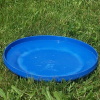Skip over navigation
Minimising the number of children who solved all four problems correctly is the same as maximising the number of children who got at least one wrong.
10 children got the first problem wrong.
15 got the second problem wrong.
20 got the third wrong.
25 got the fourth wrong.
So if they were all different children, at most 10+15+20+25=70 children got at least one question wrong.
If 70 children got at least one question wrong, 30 got all four questions right.
In the diagram below the children who correctly solved the problems are represented in green and those who didn't in red.

Lined up vertically, the parts of the bars that are green for all four questions represent the contestants who answered all four questions correctly.
To make this as small as possible, the red parts should be set up with as little overlap as possible, i.e. no overlap, as shown above.
So the smallest number of contestants who could have solved all four problems correctly is 30.

Or search by topic
Number and algebra
Geometry and measure
Probability and statistics
Working mathematically
Advanced mathematics
For younger learners
Perfect Score
Age 11 to 14
ShortChallenge Level 





- Problem
- Solutions
Minimising the number of children who solved all four problems correctly is the same as maximising the number of children who got at least one wrong.
10 children got the first problem wrong.
15 got the second problem wrong.
20 got the third wrong.
25 got the fourth wrong.
So if they were all different children, at most 10+15+20+25=70 children got at least one question wrong.
If 70 children got at least one question wrong, 30 got all four questions right.
In the diagram below the children who correctly solved the problems are represented in green and those who didn't in red.

Lined up vertically, the parts of the bars that are green for all four questions represent the contestants who answered all four questions correctly.
To make this as small as possible, the red parts should be set up with as little overlap as possible, i.e. no overlap, as shown above.
So the smallest number of contestants who could have solved all four problems correctly is 30.
You can find more short problems, arranged by curriculum topic, in our short problems collection.
You may also like
Flippin' Discs
Discs are flipped in the air. You win if all the faces show the same colour. What is the probability of winning?


